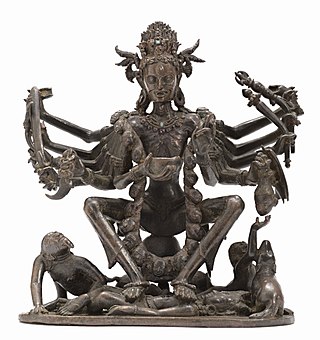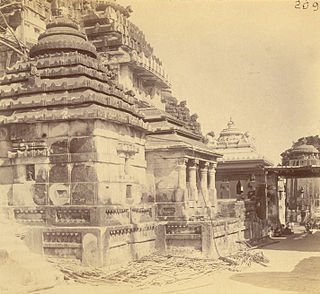
Chamunda, also known as Chamundeshwari, Chamundi or Charchika, is a fearsome form of Chandi, the Hindu mother goddess, Shakti and is one of the seven Matrikas.

Cuttack in Odia, is the former capital and the second largest city in the Indian state of Odisha. It is the headquarters of the Cuttack district. The name of the city is an anglicised form of the Odia and Sanskrit name Kataka which literally means The Fort, a reference to the ancient Barabati Fort around which the city initially developed. Cuttack is known as the Millennium City as well as the Silver City due to its history of 1000 years and famous silver filigree works. The Orissa High Court is located there. It is the commercial capital of Odisha which hosts many trading and business houses in and around the city. Cuttack is famous for its Durga puja which is one of the most important festivals of Odisha. Cuttack is also the birthplace of Netaji Subhas Chandra Bose. The city is categorised as a Tier-II city as per the ranking system used by Government of India.
Kendrapara is a Town and a municipality in the Kendrapara district of the Indian state of Odisha. It is the headquarters of Kendrapara district.
Banki is a town and a Subdivision, Legislative Council constituency no. 88 and Notified Area Council in Cuttack district in the state of Odisha, India. Banki is famous for the Charchika Temple, dedicated to the deity of Chamunda, the eight armed goddess and incarnation of Durga and for its scenic beauty. Current MLA Devi Ranjan Tripathy

The Maa Sarala Temple is a Hindu temple in the district of Jagatsinghpur, Odisha, India. It is one of the eight most famous Shakta shrines of Odisha.
This article lists the traditional festivals and other cultural events in the Odisha region of India. Odisha celebrates 13 festivals in 12 months as the saying goes Bāra Māsare Tera Parba.

The Biraja Temple, or Birija Kshetra, is a historic Hindu temple located in Jajpur, Odisha, India. The present temple was built during the 13th century. The principal idol is Devi Durga, who is worshiped as Viraja (Girija), and the temple gave Jajpur the nicknames "Viraja Kshetra" and "Biraja Peetha". The Durga idol has two hands (dwibhuja), spearing the chest of Mahishasura with one hand and pulling his tail with the other. One of her feet is on a lion, and the other is on Mahishasura's chest. Mahishasura is depicted as a water buffalo. The idol's crown features Ganesha, a crescent moon and a lingam. The temple covers a large area, and has several shrines to Shiva and other deities. According to the Skanda Purana it cleanses pilgrims, and it is called the Viraja or the Biraja kshetra. Jajpur is believed to have about one crore of Shiva lingams.

The Kataka Chandi Temple is an ancient temple dedicated to the Goddess Chandi, the presiding deity of Cuttack, Odisha, India. The temple is located nearby the banks of the Mahanadi River. It is famous for the annual Durga Puja and Kali Puja festivals. The Durga Puja festivities are prominent in Maa Katak Chandi temple which takes place for 16 days starting from dark fortnight of Ashwina Krishna Ashtami till Ashwina shukla navami and Vijayadashami. The goddess popularly called as Maa Kataka Chandi, sits and rules on the heart of the ancient city. She has four hands holding Paasha (noose), Ankusha (goad), gestures dispelling fear (Abhaya), and granting boon (Varada). She is worshiped as Bhuvaneshvari Mahavidya by Sevayatas belonging to Utkala Brahmins every day. Maa Chandi is worshipped in various incarnations of Durga during the puja. In Cuttack, people strongly believe Maa Katak Chandi as 'The Living Goddess'.

Bhattarika Temple is located on the bank of Mahanadi River, at Sasanga village in the tehsil Baramba,, Cuttack district, Odisha, India. It is dedicated to the Hindu Goddess Maa Bhattarika worshipped as a manifestation of Shakti. As per the Puranic tradition, Parashurama, facing certain defeat at the hands of Saharsrajuna, prayed to Durga who appeared on this spot to impart her divine power to his aid. The festival Pana Sankranti is celebrated here in April, Akshaya Tritiya in May and Dussehra in October.
Tourism in Odisha is one of the main contributors to the Economy of Odisha, India, with a 500 km (310 mi) long coastline, mountains, lakes, natural biodiversity and rivers. Odisha is one of the major tourism sectors of India, with various tourists' attractions, ranging from wildlife reserves, beaches, temples, monuments, the arts and festivals. Other than wildlife reserves, beaches, temples, monuments, the arts and festivals, the Odisha Tourism Development Corporation, a Public Sector Undertaking of Government of Odisha, is also developing tourism sector of Odisha and India.

Sri Lakshmi Varaha Swamy Temple is a 500-year-old Indian temple dedicated to Varaha, the boar incarnation of Vishnu.
The temple of the goddess Bhagabati, the presiding deity of the Indian town Banapur in Odisha has earned celebrity as a centre of religious activities. Once Banapur was the capital of the Sailodhvaba dynasty, responsible for the construction of the early group of temples at Bhubaneswar. The large number of Buddhist images discovered at Banapur relate the place to the Vajrayana cult of Buddhism.

Baitāḷa deuḷa or Vaitāḷa deuḷa is an 8th-century Hindu temple of the typical Khakara style of the Kalinga architecture dedicated to Goddess Chamunda located in Bhubaneswar, the capital city of Odisha, India. It is also locally known as Tini-mundia deula due to the three spires on top of it, a very distinct and unusual feature. The three spires are believed to represent the three powers of the goddess Chamunda - Mahasaraswati, Mahalakshmi and Mahakali.
Brahmani temple is a Hindu and Buddhist temple located in Avana, Baleswar, Odisha, India built in the 10th–11th centuries A.D. It is a living temple and the presiding deity is an eight-armed three-faced Chamunda image. It is a protected monument of Odisha State Archaeology.

The Vimala Temple or Bimala Temple is a Hindu temple dedicated to goddess Vimala or Bimala (ବିମଳା), located within the Jagannath Temple complex in Puri in the Indian state of Odisha. It is generally regarded as a Shakti Pitha, among the holiest temples dedicated to the Hindu Goddess.
Kuspangi is a second largest village in Banki-Dompara block under Banki tehsil and Cuttack district, in the state of Odisha, India. It is a main census village.

Deula is an architectural element in a Hindu temple in the Kalinga architecture style of the Odishan temples in Eastern India. Sometimes the whole temple is also referred to as Deula. The word "deula" in Odia language means a building structure built with a particular style that is seen in most of the temples from Odisha. Deul is also used in English, though the deul temples are also of a different form in the Manbhum region of Western Bengal.
Bangomunda a tehsil located at about 95 km from Balangir in Titlagarh sub-division of Bolangir district, Odisha, India, has historical importance. Bangomunda is the new name of Banganmura which means Brinjal Firm.
Sisua is a medium-sized village in the Salipur taluk/mandal/tehsil/block of Cuttack district in the state of Odisha, India, close to the new Sisua Village Jagannath Temple. The village lies South of Cuttack to Kendraparda road left of Sisua village road if traveling South. As of 2009 Kantapara is the gram panchayat of Sisua village














